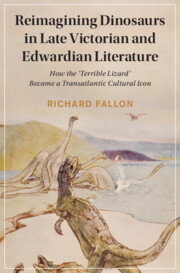 Reimagining Dinosaurs in Late Victorian and Edwardian Literature
Reimagining Dinosaurs in Late Victorian and Edwardian Literature Book contents
- Reimagining Dinosaurs in Late Victorian and Edwardian Literature
- Cambridge Studies in Nineteenth-Century Literature and Culture
- Reimagining Dinosaurs in Late Victorian and Edwardian Literature
- Copyright page
- Contents
- Figures
- Acknowledgements
- Note on Scientific Terminology
- Introduction Dinosaurs in Transition
- Chapter 1 Reclaiming Authority: Henry Neville Hutchinson, Popular Science, and the Construction of the Dinosaur
- Chapter 2 Reinventing Wonderland: Jabberwocks, Grotesque Monsters, and Dinosaurian Maladaptation
- Chapter 3 Rearticulating the Nation: Transatlantic Fiction and the Dinosaurs of Empire
- Chapter 4 Rediscovering Lost Worlds: Arthur Conan Doyle and the Modern Romance of Palaeontology
- Conclusion Dinosaurs Rewritten
- Notes
- Bibliography
- Index
- CAMBRIDGE STUDIES IN NINETEENTH-CENTURY LITERATURE AND CULTURE
Introduction - Dinosaurs in Transition
Published online by Cambridge University Press: 28 October 2021
- Reimagining Dinosaurs in Late Victorian and Edwardian Literature
- Cambridge Studies in Nineteenth-Century Literature and Culture
- Reimagining Dinosaurs in Late Victorian and Edwardian Literature
- Copyright page
- Contents
- Figures
- Acknowledgements
- Note on Scientific Terminology
- Introduction Dinosaurs in Transition
- Chapter 1 Reclaiming Authority: Henry Neville Hutchinson, Popular Science, and the Construction of the Dinosaur
- Chapter 2 Reinventing Wonderland: Jabberwocks, Grotesque Monsters, and Dinosaurian Maladaptation
- Chapter 3 Rearticulating the Nation: Transatlantic Fiction and the Dinosaurs of Empire
- Chapter 4 Rediscovering Lost Worlds: Arthur Conan Doyle and the Modern Romance of Palaeontology
- Conclusion Dinosaurs Rewritten
- Notes
- Bibliography
- Index
- CAMBRIDGE STUDIES IN NINETEENTH-CENTURY LITERATURE AND CULTURE
Summary
This introduction sketches a cultural history of dinosaur palaeontology in the nineteenth and early twentieth centuries, indicating how the book addresses the lack of literary work on the understanding of dinosaurs in this period. While dinosaurs were a British area of science in the first half of the nineteenth century, American palaeontologists took clear pre-eminence in this field from the 1870s. American research transformed dinosaurs from giant lizards into a far stranger and more heterogenous group. Fallon argues that literary scholars have not yet grappled with this cultural shift in perceptions of the dinosaurs, an omission made all the more striking by the fact that it was during the decades around 1900 that ‘dinosaur’ first became a household word. Built into this word were important ideas about imperialism, progress, romance, and the practice of science. Fallon explains how exploring this subject provides wider insights into the relationships between literature and science and between popular and specialist science writers, in addition to its value as a case study on the transatlantic nature of literary media at the end of the nineteenth century.
Keywords
- Type
- Chapter
- Information
- Reimagining Dinosaurs in Late Victorian and Edwardian LiteratureHow the ‘Terrible Lizard' Became a Transatlantic Cultural Icon, pp. 1 - 28Publisher: Cambridge University PressPrint publication year: 2021
